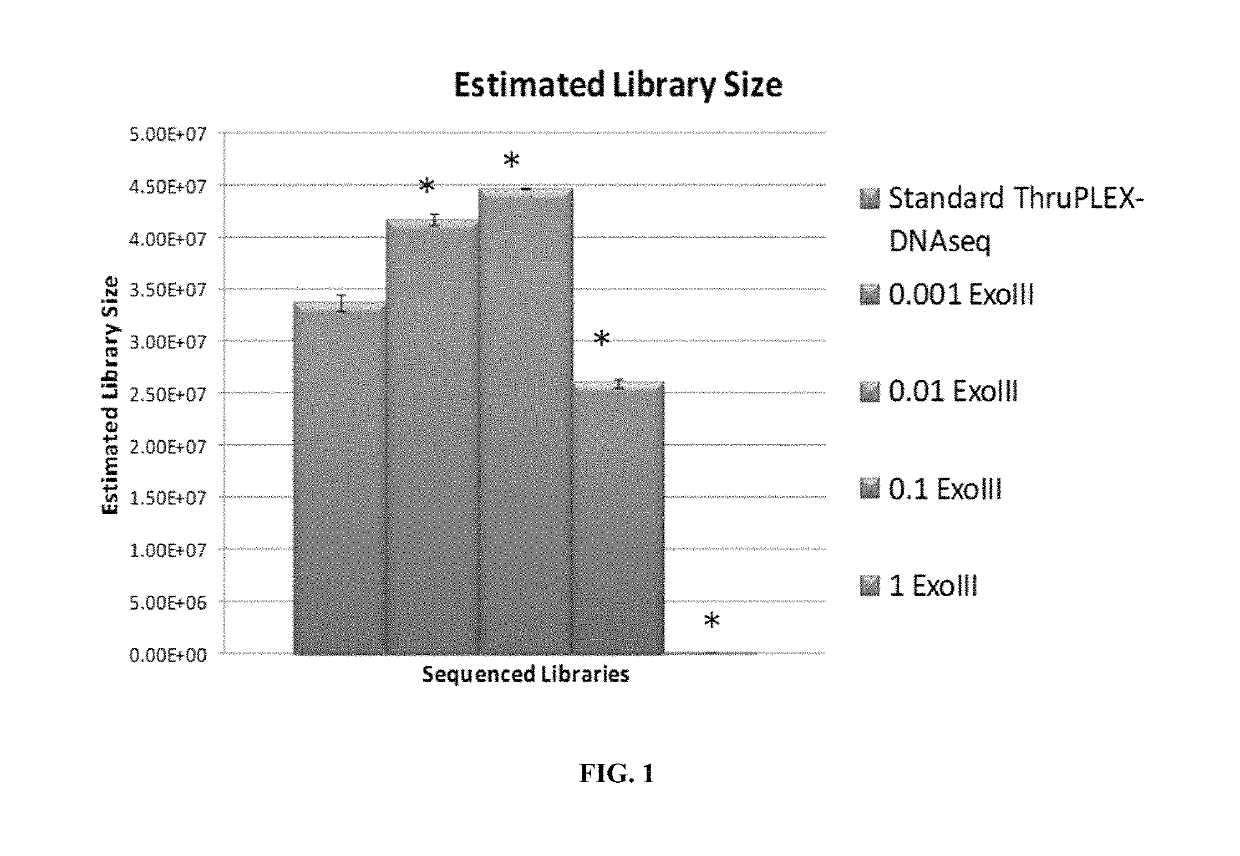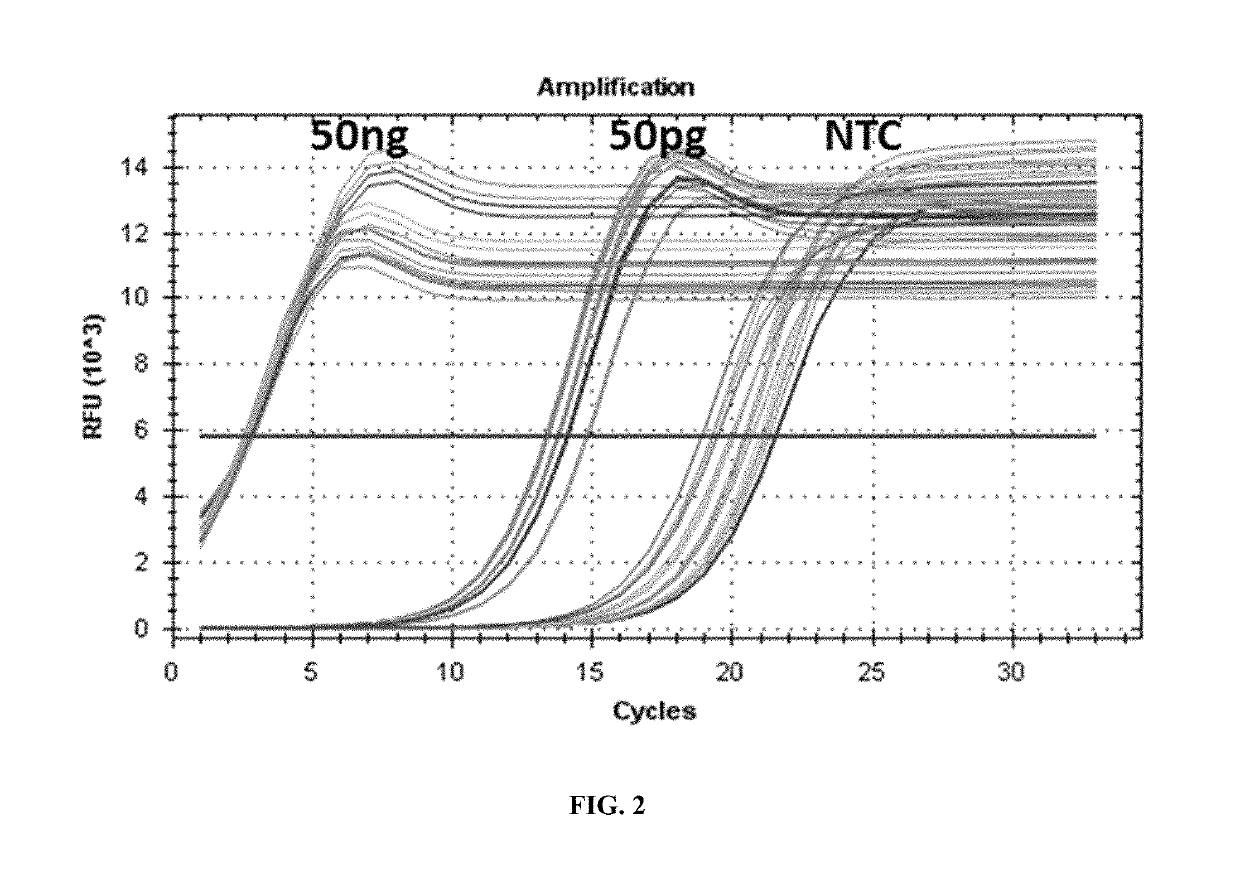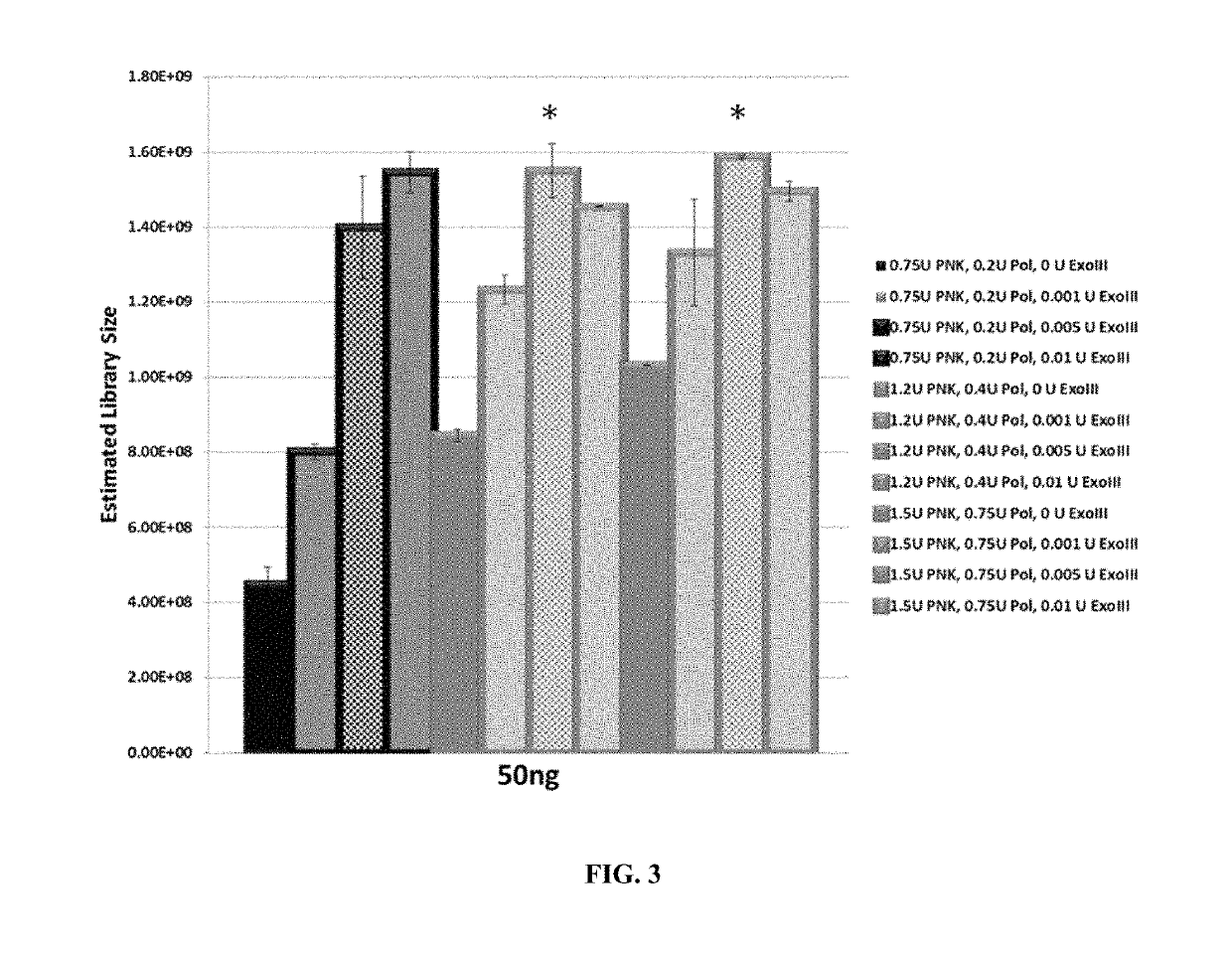Methods and compositions for repair of DNA ends by multiple enzymatic activities
a technology of dna end and enzymatic activity, applied in the field of molecular biology, can solve the problems of incompetence for ligation and inextending the end containing a 3′ phosphate, and achieve the effects of improving the sensitivity of ngs library preparation, and improving the utilization rate of damaged dna
- Summary
- Abstract
- Description
- Claims
- Application Information
AI Technical Summary
Benefits of technology
Problems solved by technology
Method used
Image
Examples
example 1
Titration of ExoIII at Fixed Concentrations of T4Pol and T4PNK
[0079]First, the presence of residual 3′ phosphate in sonicated DNA was determined and the ability of ExoIII to repair the damaged end and generate a 3′-OH was measured by monitoring amplification curves and high impact sequencing metrics. To this end, 200 pg of 500 bp Covaris-sheared reference NGS libraries were generated in duplicate using a ThruPLEX DNA-Seq library preparation kit (Rubicon Genomics, Inc.). ExoIII was added to the end-repair reactions at 0, 0.001, 0.01, 0.1, and 1.0 U / reaction. T4Pol and T4PNK were present in the reaction at 0.04 U and 2.0 U, respectively. The addition of ExoIII resulted in a biphasic dose-dependent effect on library size diversity (estimated library size; FIG. 1). Library diversity improved by 25% at 0.001 U and 34% at 0.01 U of ExoIII, but dropped by 23% and 99% at 0.1 U and 1 U of ExoIII, respectively. Thus, a significant fraction of the 3′ ends of sonicated DNA remain damaged and ca...
example 2
Titration of ExoIII at Varying Ratios of T4PNK and T4Pol
[0082]ExoIII was titrated at three different T4PNK / T4Pol ratios. The matrix was based on previous results of T4PNK / T4Pol titrations and the results of ExoIII titration (see Example 1). Titration of T4PNK and T4Pol was performed in duplicate using initial run-off amplification metrics followed by preparation of samples for sequencing, which were terminated at approximately mid-exponential amplification. End-repair reactions were performed on 50 ng and 50 pg of sheared input DNA using either 0.2 U T4Pol / 0.75 U T4PNK, 0.4 U T4Pol / 1.2 U T4PNK, or 0.75 U T4Pol / 1.5 U T4PNK, and either 0 U, 0.001 U, 0.005 U, or 0.01 U ExoIII. The estimated library sizes for 50 ng and 50 pg of input DNA are shown in FIGS. 3 and 4, respectively. The average threshold cycle determined for each pair of duplicate samples is shown in FIG. 5 and provided in Tables 2-3.
[0083]
TABLE 2Average Threshold Cycle for 50 pg of Input DNA (corresponds to FIG. 3)T4PNK / T4...
example 3
Titration of Klenow
[0086]Titration of Klenow was with duplicate samples using initial run-off amplification metrics, followed by NGS samples prepared for sequencing (ThruPLEX DNA-Seq library preparation kit, Rubicon Genomics, Inc.) using 1.2 U of T4PNK, 0.4 U of T4Pol, and 0.005 U of ExoIII per 15 μl reaction. The following units of Klenow per 15 μl reaction were tested: 0 U, 0.001 U, 0.1 U, 1.0 U. Libraries prepared for sequencing were terminated at approximately mid exponential amplification. The estimated library sizes for 50 ng and 50 pg of input DNA are shown in FIGS. 6A and 6B, respectively.
[0087]
TABLE 4Average Threshold Cycle for 50 ng of Input DNA(corresponds to FIGS. 6A-B)InputKlenow U50 ng50 pgNTC0.0002.0312.8621.030.0012.2012.2621.050.012.2112.1620.990.102.4112.3120.891.02.2212.2521.08
PUM
| Property | Measurement | Unit |
|---|---|---|
| pH | aaaaa | aaaaa |
| temperature | aaaaa | aaaaa |
| hydrodynamic shear force | aaaaa | aaaaa |
Abstract
Description
Claims
Application Information
 Login to View More
Login to View More - R&D
- Intellectual Property
- Life Sciences
- Materials
- Tech Scout
- Unparalleled Data Quality
- Higher Quality Content
- 60% Fewer Hallucinations
Browse by: Latest US Patents, China's latest patents, Technical Efficacy Thesaurus, Application Domain, Technology Topic, Popular Technical Reports.
© 2025 PatSnap. All rights reserved.Legal|Privacy policy|Modern Slavery Act Transparency Statement|Sitemap|About US| Contact US: help@patsnap.com



